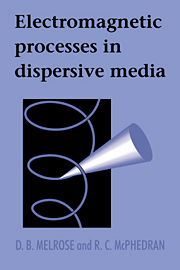Book contents
- Frontmatter
- Contents
- Preface
- List of Symbols
- Part One Electromagnetic Fields in Vacuo
- Part Two Electromagnetic Responses of Media
- Chapter 6 The Response of a Medium
- Chapter 7 General Properties of Response Tensors
- Chapter 8 Analytic Properties of Response Functions
- Chapter 9 Response Tensors for Some Idealized Media
- Chapter 10 Response Tensors for Plasmas
- Part Three Wave Properties
- Part Four Theory of Emission Processes
- Part Five Specific Emission Processes
- Bibliographic Notes
- Index
Chapter 6 - The Response of a Medium
Published online by Cambridge University Press: 27 October 2009
- Frontmatter
- Contents
- Preface
- List of Symbols
- Part One Electromagnetic Fields in Vacuo
- Part Two Electromagnetic Responses of Media
- Chapter 6 The Response of a Medium
- Chapter 7 General Properties of Response Tensors
- Chapter 8 Analytic Properties of Response Functions
- Chapter 9 Response Tensors for Some Idealized Media
- Chapter 10 Response Tensors for Plasmas
- Part Three Wave Properties
- Part Four Theory of Emission Processes
- Part Five Specific Emission Processes
- Bibliographic Notes
- Index
Summary
Preamble
There are two different descriptions of the electromagnetic response of a medium. One, which is the older description, involves introducing the polarization and magnetization of the medium and was originally applied to the response to static fields. This method may be generalized to apply to fluctuating fields but it becomes cumbersome and ill-defined for sufficiently general media. The other description is based on the use of Fourier transforms and so applies only to fluctuating fields. The Fourier transform description is used widely in plasma physics, and although it is less familiar than the other description when applied to dielectrics and magnetizable media, it is simpler and no less general than the older description.
Static Responses
The response of a medium to a static uniform electromagnetic field is described in terms of induced dipole moments. On a microscopic level a static uniform electric field polarizes the atoms or molecules. The polarizationP is defined as the induced electric dipole moment per unit volume. A medium which becomes polarized in this way is called a dielectric.
The response of a magnetizable medium to a static uniform magnetic field is attributed to induced magnetic dipole moments and is described in terms of the magnetizationM, which is defined as the induced magnetic dipole moment per unit volume. Magnetizable media are classified as paramagnetic or diamagnetic depending on whether the magnetization is parallel or antiparallel, respectively, to the applied magnetic field.
- Type
- Chapter
- Information
- Electromagnetic Processes in Dispersive Media , pp. 64 - 78Publisher: Cambridge University PressPrint publication year: 1991



